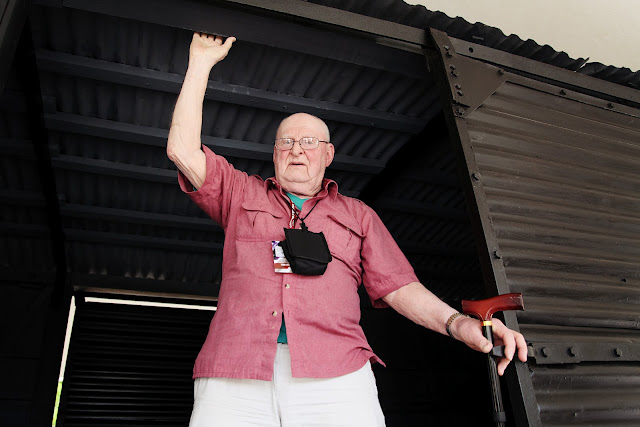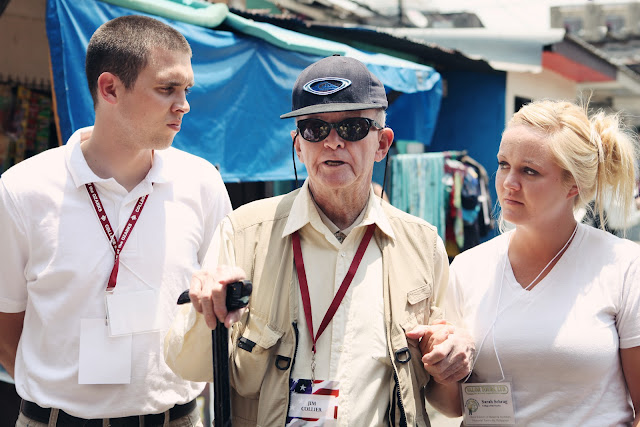 |
| Weston Wiebe and Ed Knight enjoy their time during their voyage around the island. |
 |
| Jim Collier shared with us his experience during the war. |
 |
| Today several of the guys explored old military tunnels and caves that run throughout the island. |
 |
| Dr. Fred Mullinax stands in the remains of what was once a hospital with the capacity to house 1000 men. |
 |
| Bob Ehrhart, Katie Klug, Dr. Mullinax and Jonathan Wahl spent part of their night exploring the Malinta Tunnel where U.S. troops took refuge during the attacks on Corregidor. |
This foreign land comes to life when you are with veterans who fought here in WWII. The trees, the caves, and the hills all have a story to tell. None mean more, though, than hearing the stories of our veterans.
This morning we awoke early to start on a banca tour around the gorgeous island of Corregidor. It was quite interesting to see the hills that Bob Ehrhart fought from and to be below the guns of Jim Collier’s battery. I had the opportunity to not only see these places, but also to hear the stories of Mr. John Hogue, a member of our group who was born on this island of Corregidor and was interned during the war in the citizen camp at Santo Tomas. He told me many interesting stories about the island as well as stories about himself. His story is amazing to hear, almost as wonderful as hearing from the veterans themselves.
For those of you who have been reading the blogs and are wondering which veteran I will be talking about, you are in for a surprise. I am not with a veteran. Why, then, did I come on this trip? Well, I made this trip for a special reason—to learn more about my great-uncle. I am the great-niece of a man named Linus Marlow who fought in Bataan and marched in the Death March. It wasn’t until high school that I knew he had served in World War II, and it wasn’t until this trip that I began striving to know more.
When I first heard about this trip, there was a sense of urgency in applying for an opening. I had already been on a trip before, so I knew there was a slim chance of getting in. However, because my family ties are so tight, I knew I needed to come. Fortunately, this trip is different than the rest. On this trip, there are three groups of people coming along with the students—the liberators of Bataan, the POWs from Bataan and Corregidor, and the descendants. That’s where I come in. My great-uncle was a survivor, which qualified me to go. It wasn’t until we got here that I realized how life altering it could be.
I didn’t know a lot about what my great-uncle experienced here except for stories from other survivors and from what my mom told me. Linus Marlow died a year before I was born, so I wasn’t able to hear first hand any of his stories. One thing I did know was that on the first night he was home from the war, he stayed up telling his stories from his years in POW camp but then never talked about it again. It made me wonder what would have happened if he were still alive? Would he be proud of me for coming on this trip? Would he want to come too? I don’t know for sure, but I think that it would warm his heart to know that I was so interested in him and his story.
Three things happened during the time we’ve been on this trip that have contributed to my strengthened feelings of pride in our country. The first was when we walked the last kilometer of the Death March. I could imagine Linus Marlow’s exhausted and beaten body dragging across the very same ground that I was walking along. It was chilling.
The next thing that contributed to these feelings was when we walked up to the American Memorial at Camp O’Donnell where the units who came through the camp are listed. I ran my eyes over the list until I saw “17th Pursuit Squadron” on the wall. That was the unit my uncle was in. Feelings of pride and also sadness of what he had to endure to survive filled me within. It made it real that he was here.
Lastly, I gained a sense of pride not only in our country, but also in my uncle when I was talking to another descendant. I told him who my uncle was and that we knew that he ended up in Japan, but we were not sure what ship he went on. He was able to look up his name and find out which Hellship he had been on from the Philippines to Japan. He was on the Canadian Inventor. I now have another place added to the list of areas where my uncle had been. It almost overwhelmed me.
I’ve never been in the face of war. I’ve never seen, with my own eyes, people beaten for no reason at all. I’ve never been starved and on the verge of death. I’ve always lived in a free country. I’ve always had rights. I’ve always known where my next meal will come from. This list of things I’ve always done is possible because of our veterans who lived the horrors of the list of things I’ve never done. My great-uncle, along with the veterans on this trip, saw death, destruction, and devastation in order to secure that you and I would never have to see anything like it again.
Culea Abraham





















































